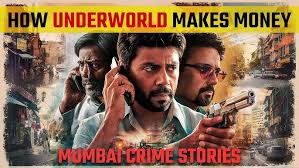The Allure of India’s Underworld on Screen
Indian gangster movies have always been a favourite among masses due to its realistic depiction of crimes, power and human mind. These movies crawl deep inside the gut of society and serve as a microscope through which you can see the intricacies of morality, ambition, and survival. From the busy boulevards of Mumbai to the coal mines of Dhanbad, Indian films have portrayed the rise and fall of these gangsters, mirroring the social and political milieu of the era.
The Genesis: Early Depictions of Crime in Indian Cinema
The depiction of gangsters has been explored in Indian cinema since Deewaar (1975) brought them into the spotlight as an “angry young man” turned to a life of crime. It is the film that established the precedent for future stories about family and crime. But Satya (1998) changed the rules of the game with its realistic portrayal of the grimy maze of Mumbai’s underworld.
Pioneering Films That Redefined the Genre
Satya (1998): The Birth of Mumbai Noir
Directed by Ram Gopal Varma, Satya is often hailed as a landmark in Indian cinema. The film follows the journey of an innocent man who becomes entangled in Mumbai’s criminal underworld. Its realistic portrayal of gang life, combined with stellar performances, especially by Manoj Bajpayee as Bhiku Mhatre, set a new standard for gangster films.
Nayakan (1987): The Godfather of Indian Cinema
Mani Ratnam’s Nayakan is about a slum dweller, Velu Naicker who becomes a dreaded don in Bombay. Loosely based on the life of gangster Varadarajan Mudaliar, the film is about an undereducated ruffian, who is being used as a hitman by the gang. Kamal Haasan’s dynamic role got him a National Film Award, and TIME Magazine has included the movie in its list of “All-Time 100 Best Films”.
Gangs of Wasseypur (2012): A Modern Epic
Anurag Kashyap’s Gangs of Wasseypur (in two-parts) tracks the coal mafia’s ascent in Dhanbad spread over decades. Darkly comic and bluntly told, the film is a deep dive into the intersection of crime and politics, with an ensemble cast to match. Growing in international reputation (The Guardian included it on their list of the ‘100 best films of the 21st century’), this paints its importance.
Recurring Themes in Indian Gangster Films
- Moral Ambiguity: Characters often grapple with ethical dilemmas, blurring the lines between right and wrong.
- Familial Ties: Many narratives explore the impact of crime on family dynamics, emphasizing loyalty and betrayal.
- Socio-Political Commentary: These films frequently reflect societal issues, from corruption to class struggles.
- Rise and Fall: A common arc involves the protagonist’s ascent in the criminal world, followed by an inevitable downfall.
The Evolution: From Grit to Glamour
Whereas gangster films of the past were steeped in reality, modern efforts have enjoyed playing around with form and structure. E.g.,Jewel Thief: The Heist Begins (2025) tries to mix old-school heist with futuristic design. But the game has faced criticism for being less deep and less original than its forebears, underscoring the difficulty of innovating in this genre.
Impact on Indian Cinema and Culture
Bollywood gangster movies not just entertain, but also have inspired cinema as well as stories. They have brought audiences into the world of flawed characters, subverted societal expectations, and propelled a new generation of filmmakers to seek out atypical stories. The acceptance of the genre has also led to international recognition, proving how well India can tell stories on a global scale.
The Enduring Legacy of Indian Gangster Films
Whether set in the city streets of Mumbai or the coalfields of Dhanbad, Indian gangster films have brought some of the most riveting stories about ambition, power and redemption. Their power to reflect the world back to itself means they are endlessly up-to-date. And as filmmakers boldly experiment and audiences clamour for more layered narratives, the genre looks set to change, mirroring the diverse fabric of Indian society.
Frequently Asked Questions (FAQ)
Q1: What are some must-watch Indian gangster films? A: Satya (1998), Nayakan (1987), and Gangs of Wasseypur (2012) are seminal works that have defined the genre.
Q2: How have Indian gangster films influenced global cinema? A: Films like Nayakan have received international acclaim, influencing filmmakers worldwide and showcasing India’s narrative depth.
Q3: Are Indian gangster films based on real events? A: Many draw inspiration from real-life figures and events, adding authenticity to their narratives.
Q4: What distinguishes Indian gangster films from Western ones? A: Indian films often intertwine crime narratives with familial and societal themes, offering a unique cultural perspective.
Q5: How has the portrayal of gangsters evolved in Indian cinema? A: While early films focused on moral dilemmas and realism, recent entries have experimented with style, narrative structures, and broader socio-political themes.